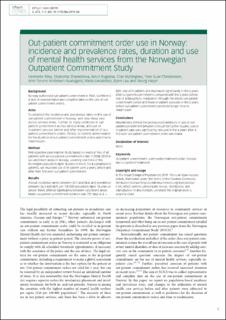| dc.contributor.author | Riley, Henriette | |
| dc.contributor.author | Sharashova, Ekaterina | |
| dc.contributor.author | Rugkåsa, Jorun | |
| dc.contributor.author | Nyttingnes, Olav | |
| dc.contributor.author | Christensen, Tore Buer | |
| dc.contributor.author | Austegard, Ann-Torunn Andersen | |
| dc.contributor.author | Løvsletten, Anna Maria | |
| dc.contributor.author | Lau, Bjørn | |
| dc.contributor.author | Høyer, Georg | |
| dc.date.accessioned | 2020-02-25T08:32:41Z | |
| dc.date.available | 2020-02-25T08:32:41Z | |
| dc.date.created | 2019-09-03T16:09:23Z | |
| dc.date.issued | 2019 | |
| dc.identifier.citation | BJPsych Open. 2019, 5, 1-7. | nb_NO |
| dc.identifier.issn | 2056-4724 | |
| dc.identifier.uri | https://hdl.handle.net/11250/2643539 | |
| dc.description | This is an Open Access article, distributed under the terms of the Creative Commons Attribution licence which permits unrestricted re-use, distribution, and reproduction in any medium, provided the original work is properly cited. | nb_NO |
| dc.description.abstract | Background Norway authorised out-patient commitment in 1961, but there is a lack of representative and complete data on the use of out-patient commitment orders. Aims To establish the incidence and prevalence rates on the use of out-patient commitment in Norway, and how these vary across service areas. Further, to study variations in out-patient commitment across service areas, and use of in-patient services before and after implementation of out-patient commitment orders. Finally, to identify determinants for the duration of out-patient commitment orders and time to readmission. Method Retrospective case register study based on medical files of all patients with an out-patient commitment order in 2008–2012 in six catchment areas in Norway, covering one-third of the Norwegian population aged 18 years or more. For a subsample of patients, we recorded use of in-patient care 3 years before and after their first-ever out-patient commitment. Results Annual incidence varied between 20.7 and 28.4, and prevalence between 36.5 and 48.9, per 100 000 population aged 18 years or above. Rates differed significantly between catchment areas. Mean out-patient commitment duration was 727 days (s.d. = 889). Use of in-patient care decreased significantly in the 3 years after out-patient commitment compared with the 3 years before. Use of antipsychotic medication through the whole out-patient commitment period and fewer in-patient episodes in the 3 years before out-patient commitment predicted longer time to readmission. Conclusions Mechanisms behind the pronounced variations in use of out-patient commitment between sites call for further studies. Use of in-patient care was significantly reduced in the 3 years after a first-ever out-patient commitment order was made. | nb_NO |
| dc.language.iso | eng | nb_NO |
| dc.rights | Navngivelse 4.0 Internasjonal | * |
| dc.rights.uri | http://creativecommons.org/licenses/by/4.0/deed.no | * |
| dc.title | Out-patient commitment order use in Norway: incidence and prevalence rates, duration and use of mental health services from the Norwegian Outpatient Commitment Study | nb_NO |
| dc.type | Journal article | nb_NO |
| dc.type | Peer reviewed | nb_NO |
| dc.description.version | publishedVersion | nb_NO |
| dc.rights.holder | ©The Royal College of Psychiatrists 2019. | nb_NO |
| dc.source.pagenumber | 1-7 | nb_NO |
| dc.source.volume | 5 | nb_NO |
| dc.source.journal | BJPsych Open | nb_NO |
| dc.identifier.doi | 10.1192/bjo.2019.60 | |
| dc.identifier.cristin | 1721134 | |
| cristin.unitcode | 222,56,1,0 | |
| cristin.unitname | Institutt for sykepleie- og helsevitenskap | |
| cristin.ispublished | true | |
| cristin.fulltext | original | |
| cristin.qualitycode | 1 | |

